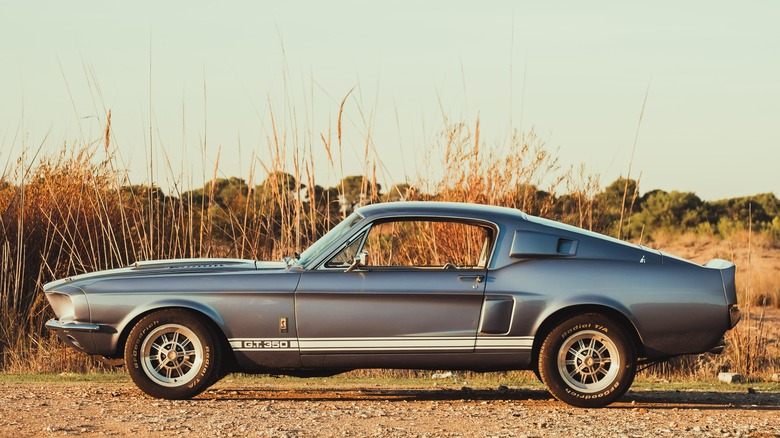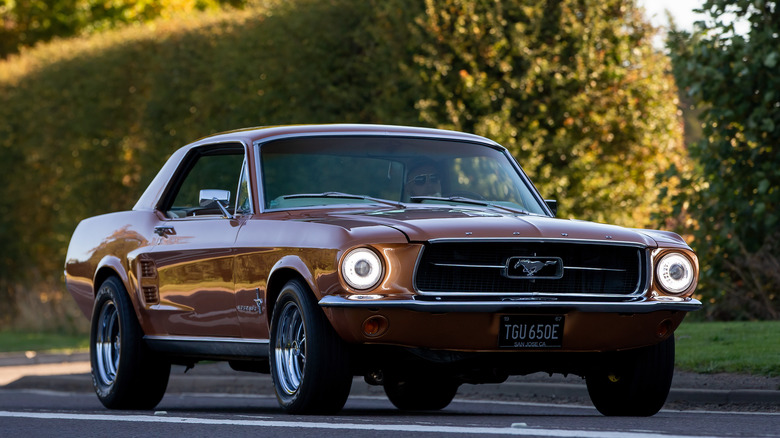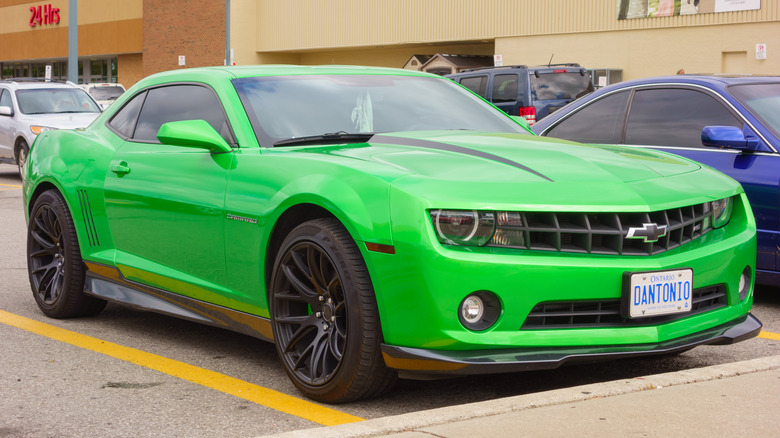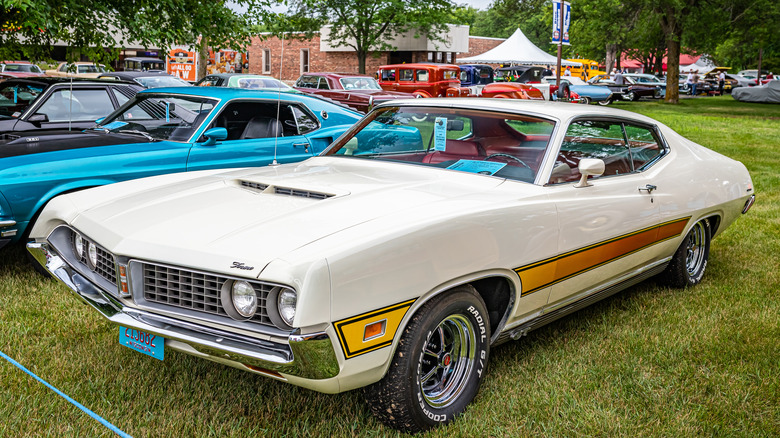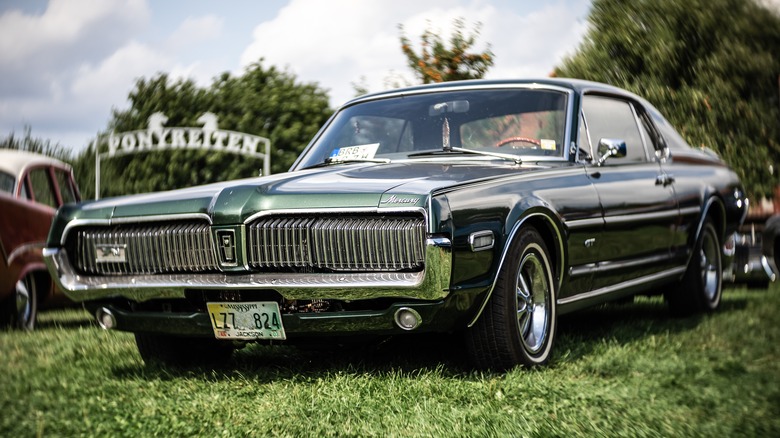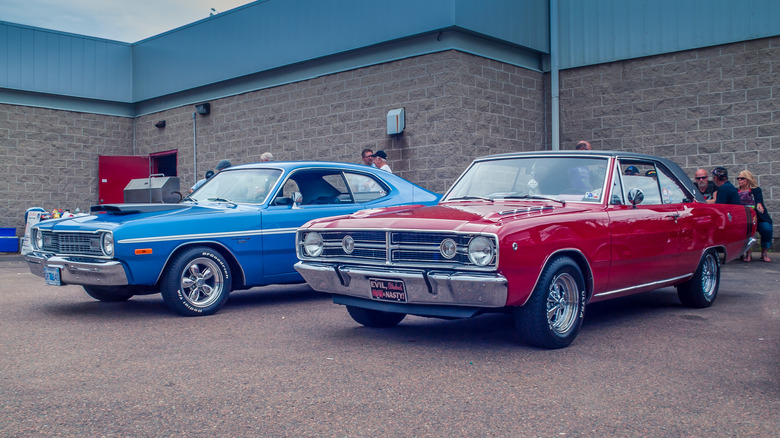5 Fast Muscle Cars That Are Easy And Cheap To Maintain
Tearing down a country road in a muscle car is a wonderful experience, but the costs associated with maintaining a classic can put a lot of people off. However, if you're a little flexible, it's possible to own a piece of classic American muscle without destroying your savings account. There are basically three rules if you want to drive a muscle car without stacking up a bunch of unnecessary expenses.
The first rule is, older is better. Most cars were a little less complex and easier to work on back in the day. They lacked overly complex electrical systems, while engine bays tend to have a generous amount of room and plenty of accessibility. You can fix a lot of problems on an old muscle car with a socket set, a manual, and a bit of patience. The second rule relates to reliability, as some older engines are practically bulletproof — so picking up a model known for not letting its owner down can save you in the long run.
Finally, avoid collector's items. You can still get the muscle car experience without taking things too far. While a collectible vehicle is a talking point, maintaining it properly and hunting down original parts when things go wrong costs a fortune. Instead, opt for something less desirable and ideally something you can slap a cheap aftermarket part on without feeling like you're defacing a work of art.
Ford Mustang
The Ford Mustang is one of the most iconic muscle cars in existence, and there's a good argument that it's actually the most revered. It was the ride of choice for Frank Bullitt, Thomas Crown, and even James Bond. As a result, some 'Stangs are damned expensive — with particularly desirable examples selling for millions. However, not all Mustangs are created equal, and you can get your hands on one for a few thousand dollars if you're not picky.
Mustangs from the late 1980s through the 1990s tend to cost less than Mark I and II models, with several examples in good working order available on the likes of eBay and Facebook Marketplace for less than $5,000. If you look at vehicles from the early 2000s, you may even spot a Mustang GT, complete with its notoriously reliable V8, up for grabs in this price bracket.
If you're prepared to put some work in, you can get a more desirable model for under $10,000 and restore it to its former glory. Though if you want a truly spectacular example of the 'Stang, $10,000 may not even get you a rusted-out chassis. In terms of ongoing maintenance, many of the cheaper models are over 25 years old, and should qualify for classic car insurance — which can save you a fair amount. As they're one of Ford's more popular lines, it should also be easy to get second-hand or aftermarket parts at competitive prices, which again reduces costs.
Fifth Generation Chevvy Camaro
The Chevvy Camaro is on many a muscle car top 10 list — and its popularity means many of them were produced. You have six generations to choose from, and plenty of bargains are available if you look hard enough. Even if you pay a little more than you intended to for your Chevvy, there's a good chance it will pay you back through reliability alone.
Keep an eye out for models from the fifth generation — which ran from 2003 to 2015. The 2013 model in particular had a very reliable engine, and in 2010, base models were cranking out more power than special editions had during the muscle car's golden age.
If something expensive goes wrong, it's likely to go wrong in the engine department. An issue with something like a head gasket, thermostat, water pump, or timing belt is already an expensive fix and can result in catastrophic engine damage. So a bulletproof engine, and a bit of luck, can save you thousands of dollars in the long run.
Ford Torino GT
If you think of a muscle car built by Ford, the Mustang is likely to spring to mind. Back in the 1960s, which was arguably the golden age of the big block muscle car, Ford had a few other options on the market besides the Mustang. One of those was the Torino GT, which was essentially a sporting version of the Fairlane 500.
You had a choice of three styles: hard top, convertible, or fastback. A number of engine options were also on offer, and some are more desirable than others. A 390 cubic inch V8 engine — which was either capable of 265 horsepower when fitted with a two-barrel carburetor, and 325 horsepower if the original buyer stumped up for the four-barrel version. If you really wanted to go for it, you could opt for the 427 cubic inch engine, which could produce a fearsome 390 horsepower.
On the outside, the Torino GT and the Mustang are clearly different. But underneath it all, they're quite similar. The 1968 model in particular uses a lot of "Mustang" parts. So if you get your hands on one, you can be safe in the knowledge that spares are plentiful, easy to source, and relatively cheap.
Late 1960s Mercury Cougar
While the "Cougar" name ended up on a wide array of vehicles as time went on, the original late-1960s variants were muscle cars. The Cougar concept actually predates the more famous 'Stang, but didn't actually hit the road until a couple of years later. If you like the idea of a classic Mustang, but want a few luxury touches and flip-up headlights, then this may be the muscle car for you.
The Cougar is pretty cheap to maintain for a couple of reasons. Mercury was a division of Ford back when it existed. As a result, the Cougar contained lot of parts you will also find on Mustangs from the same era. This is why the muscle car is often written off as a Mustang clone.
As you may have noticed, the Ford Mustang was a ridiculously popular car, and there are probably more bits of old Mustang sitting in junkyards than there are bits of any other muscle car. Aftermarket parts are also pretty easy to get for each generation of Mustang.
Luckily, the ease of sourcing parts doesn't stop there. The Mercury Cougar itself was a pretty popular choice back in the day. Over 400,000 rolled off the production line, so if you want a used part that actually spent its life on a mercury Cougar, it should be pretty cheap and easy to find.
Dodge Dart
The Dodge Dart may not get as much love as some of its siblings, but it can be a great option if you want to save a little cash and aren't too bothered about opting for something with a smaller engine.
A Dodge Dart won't cost you much to start with, with examples available for less than $10,000. You'll want to look out for the more powerful Dart Sport 360 variants, which rolled off the production line between 1974 and 1976 — though these tend to be more desirable. If you find the Dart equivalent of the holy grail, expect a 5.8 liter V8 capable of producing around 200 horsepower. Most Darts pack a little less of a punch than that, hence their status as a "Pony Car."
As with most other popular American vehicles of the 1970s, junkyards, eBay, and aftermarket sellers are all great sources of extra parts if your ride needs repairing or restoring. You can also do a lot of the work yourself, with only basic tools.
